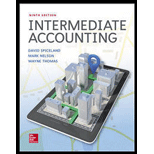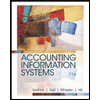
INTERMEDIATE ACCOUNTING (LL) W/CONNECT
9th Edition
ISBN: 9781260679694
Author: SPICELAND
Publisher: MCG
expand_more
expand_more
format_list_bulleted
Concept explainers
Textbook Question
Chapter 3, Problem 3.14E
FASB codification research
• LO3–2, LO3–4
Access the FASB Accounting Standards Codification at the FASB website (www.fasb.org). Determine the specific citation for each of the following items:
- 1. What is the
balance sheet classification for a note payable due in six months that was used to purchase a building? - 2. Which assets may be excluded from current assets?
- 3. Should a note receivable from a related party be included in the balance sheet with notes receivable or
accounts receivable from customers? - 4. What items are nonrecognized subsequent events that require a disclosure in the notes to the financial statements?
Expert Solution & Answer
Want to see the full answer?
Check out a sample textbook solution
Students have asked these similar questions
If a company fails to adjust for accrued salaries, the result will be:A. Understated expensesB. Overstated liabilitiesC. Overstated assetsD. No impact
I need help finding the accurate solution to this general accounting problem with valid methods.
Unhelpful if you are not sure about this accounting questions and answer
Chapter 3 Solutions
INTERMEDIATE ACCOUNTING (LL) W/CONNECT
Ch. 3 - Prob. 3.1QCh. 3 - Prob. 3.2QCh. 3 - Define current assets and list the typical asset...Ch. 3 - Prob. 3.4QCh. 3 - Prob. 3.5QCh. 3 - Prob. 3.6QCh. 3 - Describe the common characteristics of assets...Ch. 3 - Prob. 3.8QCh. 3 - Prob. 3.9QCh. 3 - Define the terms paid-in-capital and retained...
Ch. 3 - Disclosure notes are an integral part of the...Ch. 3 - A summary of the companys significant accounting...Ch. 3 - Define a subsequent event.Ch. 3 - Prob. 3.14QCh. 3 - Prob. 3.15QCh. 3 - Prob. 3.16QCh. 3 - Prob. 3.17QCh. 3 - Show the calculation of the following solvency...Ch. 3 - Prob. 3.19QCh. 3 - Prob. 3.20QCh. 3 - (Based on Appendix 3) Segment reporting...Ch. 3 - Prob. 3.22QCh. 3 - Prob. 3.23QCh. 3 - Current versus long-term classification LO32,...Ch. 3 - Balance sheet classification LO32, LO33 The trial...Ch. 3 - Prob. 3.3BECh. 3 - Balance sheet classification LO32, LO33 Refer to...Ch. 3 - Balance sheet classification LO32, LO33 The...Ch. 3 - Balance sheet classification LO32, LO33 You have...Ch. 3 - Balance sheet preparation; missing elements LO32,...Ch. 3 - Financial statement disclosures LO34 For each of...Ch. 3 - Calculating ratios LO38 Refer to the trial...Ch. 3 - Prob. 3.10BECh. 3 - Calculating ratios; solving for unknowns LO38 The...Ch. 3 - Balance sheet; missing elements LO32, LO33, LO38...Ch. 3 - Balance sheet classification LO32, LO33 The...Ch. 3 - Balance sheet classification LO32, LO33 The...Ch. 3 - Balance sheet preparation LO32, LO33 The...Ch. 3 - Balance sheet preparation LO32, LO33 The...Ch. 3 - Balance sheet; Current versus long-term...Ch. 3 - Prob. 3.7ECh. 3 - Prob. 3.8ECh. 3 - Balance sheet preparation LO32, LO33 The...Ch. 3 - Financial statement disclosures LO34 The...Ch. 3 - Prob. 3.11ECh. 3 - Prob. 3.12ECh. 3 - Prob. 3.13ECh. 3 - FASB codification research LO32, LO34 Access the...Ch. 3 - Prob. 3.15ECh. 3 - Prob. 3.16ECh. 3 - Prob. 3.17ECh. 3 - Calculating ratios; solve for unknowns LO38 The...Ch. 3 - Prob. 3.19ECh. 3 - Effect of management decisions on ratios LO38...Ch. 3 - Prob. 3.21ECh. 3 - Prob. 3.22ECh. 3 - Balance sheet preparation LO32, LO33 Presented...Ch. 3 - Balance sheet preparation; missing elements LO32,...Ch. 3 - Balance sheet preparation LO32, LO33 The...Ch. 3 - Balance sheet preparation LO32, LO33 The...Ch. 3 - Balance sheet preparation LO32, LO33 The...Ch. 3 - Prob. 3.6PCh. 3 - Balance sheet preparation; errors LO32, LO33 The...Ch. 3 - Balance sheet; errors; missing amounts LO32, LO33...Ch. 3 - Balance sheet preparation LO32 , LO33 Presented...Ch. 3 - Prob. 3.10PCh. 3 - Communication Case 31 Current versus long-term...Ch. 3 - Analysis Case 32 Current versus long- term...Ch. 3 - Prob. 3.4BYPCh. 3 - Judgment Case 35 Balance sheet; errors LO32...Ch. 3 - Prob. 3.6BYPCh. 3 - Real World Case 37 Balance sheet and significant...Ch. 3 - Judgment Case 38 Post fiscal year-end e vents ...Ch. 3 - Prob. 3.9BYPCh. 3 - Prob. 3.10BYPCh. 3 - Prob. 3.11BYPCh. 3 - Analysis Case 314 Balance sheet information LO32...Ch. 3 - Prob. 3.15BYPCh. 3 - Ethics Case 316 Segment reporting Appendix 3 You...Ch. 3 - Prob. 1CCTC
Knowledge Booster
Learn more about
Need a deep-dive on the concept behind this application? Look no further. Learn more about this topic, accounting and related others by exploring similar questions and additional content below.Similar questions
- Please provide the correct answer to this general accounting problem using accurate calculations.arrow_forwardWhat is the purpose of a trial balance?A. Prepare financial statementsB. Detect fraudC. Verify ledger balancesD. Check for omitted transactionsneed helparrow_forwardCan you help me solve this general accounting problem with the correct methodology?arrow_forward
- 10. What is the purpose of a trial balance?A. Prepare financial statementsB. Detect fraudC. Verify ledger balancesD. Check for omitted transactionsarrow_forwardCan you solve this general accounting problem with appropriate steps and explanations?arrow_forwardAccounting question using accurate calculation methods?arrow_forward
- Dont accept if you dont know completely. otherwise you will gate down vote accounting questionarrow_forward11. Which inventory method assigns the most recent cost to cost of goods sold during inflation?A. FIFOB. LIFOC. Weighted AverageD. Specific Identification need coarrow_forwardFull explanation needed. Answer me asap, any issue in this questions please comment down below.Otherwise unhelpful accounting problemarrow_forward
- I am searching for the correct answer to this general accounting problem with proper accounting rules.arrow_forwardWhich inventory method assigns the most recent cost to cost of goods sold during inflation?A. FIFOB. LIFOC. Weighted AverageD. Specific IdentificationNeed helparrow_forwardI am trying to find the accurate solution to this general accounting problem with the correct explanation.arrow_forward
arrow_back_ios
SEE MORE QUESTIONS
arrow_forward_ios
Recommended textbooks for you
 AccountingAccountingISBN:9781337272094Author:WARREN, Carl S., Reeve, James M., Duchac, Jonathan E.Publisher:Cengage Learning,
AccountingAccountingISBN:9781337272094Author:WARREN, Carl S., Reeve, James M., Duchac, Jonathan E.Publisher:Cengage Learning, Financial & Managerial AccountingAccountingISBN:9781285866307Author:Carl Warren, James M. Reeve, Jonathan DuchacPublisher:Cengage Learning
Financial & Managerial AccountingAccountingISBN:9781285866307Author:Carl Warren, James M. Reeve, Jonathan DuchacPublisher:Cengage Learning Corporate Financial AccountingAccountingISBN:9781305653535Author:Carl Warren, James M. Reeve, Jonathan DuchacPublisher:Cengage Learning
Corporate Financial AccountingAccountingISBN:9781305653535Author:Carl Warren, James M. Reeve, Jonathan DuchacPublisher:Cengage Learning Financial & Managerial AccountingAccountingISBN:9781337119207Author:Carl Warren, James M. Reeve, Jonathan DuchacPublisher:Cengage LearningPrinciples of Accounting Volume 1AccountingISBN:9781947172685Author:OpenStaxPublisher:OpenStax College
Financial & Managerial AccountingAccountingISBN:9781337119207Author:Carl Warren, James M. Reeve, Jonathan DuchacPublisher:Cengage LearningPrinciples of Accounting Volume 1AccountingISBN:9781947172685Author:OpenStaxPublisher:OpenStax College Accounting Information SystemsFinanceISBN:9781337552127Author:Ulric J. Gelinas, Richard B. Dull, Patrick Wheeler, Mary Callahan HillPublisher:Cengage Learning
Accounting Information SystemsFinanceISBN:9781337552127Author:Ulric J. Gelinas, Richard B. Dull, Patrick Wheeler, Mary Callahan HillPublisher:Cengage Learning

Accounting
Accounting
ISBN:9781337272094
Author:WARREN, Carl S., Reeve, James M., Duchac, Jonathan E.
Publisher:Cengage Learning,

Financial & Managerial Accounting
Accounting
ISBN:9781285866307
Author:Carl Warren, James M. Reeve, Jonathan Duchac
Publisher:Cengage Learning

Corporate Financial Accounting
Accounting
ISBN:9781305653535
Author:Carl Warren, James M. Reeve, Jonathan Duchac
Publisher:Cengage Learning

Financial & Managerial Accounting
Accounting
ISBN:9781337119207
Author:Carl Warren, James M. Reeve, Jonathan Duchac
Publisher:Cengage Learning

Principles of Accounting Volume 1
Accounting
ISBN:9781947172685
Author:OpenStax
Publisher:OpenStax College

Accounting Information Systems
Finance
ISBN:9781337552127
Author:Ulric J. Gelinas, Richard B. Dull, Patrick Wheeler, Mary Callahan Hill
Publisher:Cengage Learning
Accounting for Finance and Operating Leases | U.S. GAAP CPA Exams; Author: Maxwell CPA Review;https://www.youtube.com/watch?v=iMSaxzIqH9s;License: Standard Youtube License